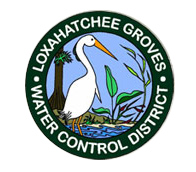The Loxahatchee Groves Water Control District approved a resolution Monday adopting a $1.6 million budget for next year, reporting $147,265 in excess revenue and no assessment increase.
The budget will include the purchase of a new tractor with a box blade, bush hog and seeder, improvements to the district’s meeting room and a truck side-pour device.
LGWCD property owners pay between $107 and $113 per acre, depending upon their location on a paved or unpaved road.
“This was a very unusual year,” Supervisor John Ryan explained. “We had $213,000 of project funds from the United States Department of Agriculture that relates back to the recovery from Tropical Storm Isaac, and even though we’ve indicated that we’ve got a surplus of $147,000, that does not count close to $45,000 of remaining billings that we have not been reimbursed for.”
LGWCD Administrator Stephen Yohe said his staff plans to submit an additional invoice that would take the excess revenue to $213,000.
Supervisor Don Widing thanked Ryan for his work on the budget, including financial discoveries he made that helped put the district in a revenue position that it had not seen in many years.
Supervisor Frank Schiola, who had recommended the purchase of the box blade and seeder, said they will go a long way toward improving the appearance of the community.
“It’s going to keep the mowing of our canals down, and it’s going to be more efficient,” Schiola said. “The way we’re mowing our flat lands right now with our mower is very inefficient. It takes a long time. This is going to be a better way of doing it.”
Schiola also recommended coordinating with the Town of Loxahatchee Groves on mowing the equestrian trails. He added that he was happy that the district was going to be able to purchase the equipment outright, at a cost of $65,000, with no need for financing.
Ryan noted that the budget proposes using $35,000 of reserves to balance expenditures, but that the line items were pretty much carried over from the previous year.
Ryan also pointed out that the $95,000 a year for equipment leasing was actually a lease/purchase for the long-reach backhoe and hydraulic arm mower obtained last year. He said the backhoe is used continuously for canal dredging and water flow improvement, while the hydraulic arm mower enables mowing all the way down the sides of the canals.
He also noted that the budget includes a 4 percent salary increase and retirement benefits for district employees.
Schiola noted that although the district does not carry a large reserve, it does have access to an emergency loan through a bank agreement.
Ryan said they had renewed a $400,000 line of credit for emergency funds.
“That line of credit is secured first by FEMA and USDA emergency watershed payments and secondarily by the assessment authority of the district,” Ryan said. “The standby fee by the bank is $1,000. That’s a very generous fee.”
Widing made a motion to approve the budget, which carried 5-0.
Supervisor Robert Snowball said he appreciated the district staff’s ability to hold down the budget despite the purchase of large pieces of equipment.
Ryan thanked Yohe and his staff for their work on the budget.
“It’s very easy to work with Steve,” Ryan said. “He has really got both feet in the process, operating the district and understanding the money flow. Hopefully we won’t have another disruptive storm. Although it’s nice to get extra money and to generate a surplus, that’s not the way I’d like to do it.”
Widing complimented staff members for their communication ability. “I’ve been many years on this board, and we always get anxious when it’s budget time,” he said. “This is probably one of the smoothest and best-communicated budget seasons that I’ve been through.”
He also thanked Ryan for his work on the budget. “I know you’re on point, and you know how to use that calculator,” Widing said.
Schiola was excited that the district will be able to get more equipment to improve the appearance of the area.
“I wanted that tractor bad, and I wanted that bush hog bad,” he said. “It’s something that we’ve been without for many years. The old ways were to hook up the bush hog to the back of a tractor, and that was an extremely inefficient way of doing it. It’s nice to have a tractor that’s going to be dedicated to mowing, seeding and box-blading where we need it.”
The improvements to the meeting room are also a plus, Schiola added. “And doing it without raising assessments one cent is outstanding,” he said.








